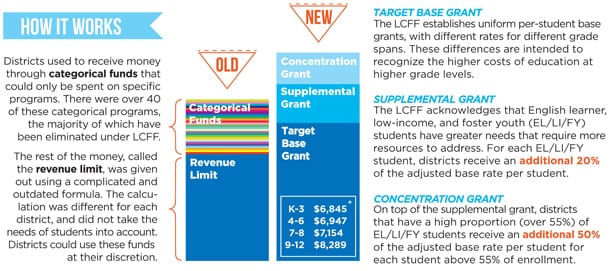LCFF: Transforming our Schools to be more Equitable
Enacted in 2013, the Local Control Funding Formula (LCFF) gives local communities control and flexibility and helps deliver resources to our most needy students. Built on a need criterion, target base grants are distributed in certain target amounts with those amounts rising when the concentration of English learner, low-income, and foster youth grow. California Teachers Association advised and advocated alongside our students and their parents during every step of the LCFF creation process, resulting in billions promised to our schools when fully implemented.
The Details on LCFF

Target Base Grant
The LCFF establishes uniform per-student base grants with different rates for different grade spans. These differences are intended to recognize the higher costs of education at the higher-grade levels.
Supplemental Grant
The LCFF acknowledges that English learner, low-income, and foster youth (EL/LI/FY) students have greater needs that require more resources to address. For each EL/LI/FY student, districts receive an additional 20% of the adjusted base rate per student.
Concentration Grant
On top of the supplemental grant, districts that have a high proportion (over 55%) of the EL/LI/FY students receive an additional 50% of the adjusted base rate per student for each student above 55% of enrollment.
RESOURCE: Making Local Control Work: An Association Leaders Guide
FAQs
You asked, we answered!
A. The law gives districts flexibility to spend their base grants as they choose. But districts must use the additional state funds—the supplemental and concentration grants—“to increase or improve services in proportion to the increase in funds” they receive for students targeted for extra money. If high-needs students are the majority, districts can use the additional money for districtwide purposes, such as extending the school day, but they must explain how the spending will principally benefit high-needs students.
A. Money from the Local Control Funding Formula accounts for about 80 percent of general funding that districts get from the state. The law requires that districts detail how they will spend the money in a document called the Local Control and Accountability Plan or LCAP. The LCAP should spell out goals for student progress and district improvement, actions and spending that the district will take to achieve them, and how the progress will be measured.
The goals should respond to eight priorities under the funding law, including how districts will improve parent engagement and school climate, implement the Common Core and new science standards, and raise student achievement so that students are prepared for college and careers.
Following a template that the State Board of Education created, the LCAP should break down how the goals and expenditures would increase or improve services and programs for each high-needs student group that receives extra funding.
A. School districts must provide opportunities for input from teachers, principals, administrators and other school personnel, the district’s unions, parents and students so that funds are spent appropriately and equitably. The LCAP lays out the process for community involvement. It is designed to be a planning tool as well as a comprehensive accountability document. The LCAP template requires that districts document how they reached out to parents, how their priorities are supported by data, and how spending decisions and expenses are aligned with district goals and priorities. The LCAP is a three-year document that must be updated annually.
At a minimum, school boards must hold a public hearing on the plan before adopting the LCAP. In addition, the funding law requires that districts reach out to students and to parents through a parent advisory committee. Districts where English learners comprise at least 15 percent of enrollment must also consult with an English learner advisory committee.
If they are not directly involved at a district level, parents should participate in discussions with their school site councils. They should insist that LCAP materials and meeting schedules be widely distributed and translated into Spanish and other languages. Parents should demand that the outreach begin early in the school year. Because LCAPs can be very lengthy, they should request clearly written and accessible summaries that explain how money will be spent.
Details: Local Control Accountability Plan and the California School Dashboard
The LCFF provides schools with greater flexibility and greater authority over resources and it requires each district to adopt a Local Control and Accountability Plan (LCAP). Tied directly to the LCFF and the LCAP is the accountability system called the California School Dashboard.
California School Dashboard
Rather than judging schools on a single test score, the Dashboard provides information about how local educational agencies and schools are meeting the needs of California’s diverse student population based on a set of multiple state and local measures. The Dashboard features easy-to-read reports on multiple measures of school success, including test scores, graduation rates, English learner progress, and suspension rates.
Local Control and Accountability Plan
The LCAP is a three-year local school district plan and was developed in collaboration with parents, educators, and the community. The LCAP describes the goals, services, and expenditures that will support positive student outcomes and increase or improve services/programs for students that receive extra funding. Also, the LCAP must address the eight state priorities and local priorities.
The eight State Priorities are:
- Teachers of the school district are appropriately assigned
- Implementation of the academic content and performance standards
- Parental Involvement
- Pupil achievement
- Pupil engagement
- School climate
- Pupil access to and enrollment in a broad course of study
- Pupil outcomes
County Offices of Education must address the eight state priorities as well as prioritize instruction of expelled students and services for foster youth.
CTA strongly supports the LCAP process which brings administrators, teachers, parents and the community together to create an accountability system that meets the needs of all students in their community.
History of School Funding Pre-LCFF
School districts used to receive money through categorical funds that could be spent on specific programs. There were over 40 of these categorical programs, the majority of which were eliminated under LCFF. The rest of the money, called the revenue limit, was given out using a complicated and outdated formula. The calculation was different for each district and did not take the needs of students into account. Districts could use these funds at their discretion.
The Local Control Funding Formula represented the most significant change in California’s funding system for K-12 schools in four decades.
What Did LCFF Change?
Before
- State-directed categorical programs
- Lack of additional funding for at-risk students
- Performance represented by a single performance indicator
- Performance measured by student test scores
- Support was prescriptive, with certain models required to be adopted
Now
- Local authority able to direct spending to greatest local needs
- Additional funding for low-income students, English learners and foster youth
- Performance represented by multiple performance indicators
- Performance measured by achievement AND growth
- Multiple measures that go beyond test scores
- Support providers work side by side with Local Education Agencies

